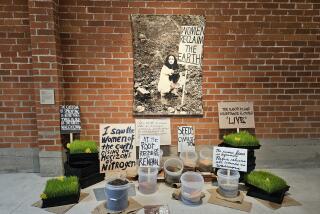“Trip Without Travel,” an Erika Suderberg work...
- Share via
SAN DIEGO — “Trip Without Travel,” an Erika Suderberg work at Installation (930 E St.), conveys through its title the spirit of the installation genre in general, including the other two works on view here by Nancy Barton and Leslie Ernst. By creating an environment, within but often subverting the gallery setting, these artists transport the viewer into a different realm, an altered state of mind.
Suderberg’s work, whose complete title is “Trip Without Travel--Irrigation Channels,” evokes an atmosphere of dislocation and confusion. A framed “Museum Plan,” presumably deciphering what is to be found within the installation space, matches terms such as “combustible” and “followers” with visual symbols--straw and sheep--but the guide itself slips into obscurity with the designation of three palm trees as a “hidden agenda” and blank white rectangles as “societal death notices.”
As such clues suggest, what awaits the visitor is no ordinary museum. Painfully dark, the room is carpeted with a thick layer of straw and filled with the recorded sounds of mumbling voices, dripping water and barking dogs. Arrangements of objects amid the straw and upon the walls use some forms recognizable from the museum plan, but Suderberg’s own agenda remains unclear. As one’s senses adjust to the environment, the physical disorientation diminishes. The psychological disorientation remains, however, questioning the meaning and purpose of the experience.
Barton’s “The Power of a Singular Vision” also employs a strategy of subversion by using the format of a promotional display to recount a personal saga. Using enlarged, mounted photographs, inspirational captions and audio accompaniment, Barton tells the story of her late father, an actor.
Large color images of Fred Barton in heroic garb and stance, juxtaposed with family snapshots and other images relating to his career, all appear to be memorial tributes to the man, but the content of the audio tape and the obvious fallacy of the posed pictures undermine his heroic stature.
The tape interweaves statements of his own earnest ambition with his wife’s lamentations about this fatal attraction to the American dream. The excessive slickness of Barton’s display parallels her father’s heroic facade: Both conceal emotion for the sake of appearance, and both leave their audience wanting.
The most provocative and effectively resolved of the three installations is Ernst’s “Get Dressed.” Its four contiguous dressing booths and their various contents cumulatively form a powerful indictment of the fashion industry.
One wall of the first booth is lined with copies of New York Times reports of the 1911 Triangle Waist Co. fire that killed nearly 150 laborers, mostly young girls. Juxtaposed with these are pages from the Fashion and Society sections of the same paper, filled with glamorous ads and articles.
Ernst expands upon the simultaneous horror and glamour of the fashion industry through illustrations and writings in all four booths, bringing the issue closest to home in the final booth, again lined with newspapers, but this time dating from 1985, and mixing images of the Mexico City earthquake’s ravages with current fashion advertisements. Some people die for fashion, others are simply slaves to it. Ernst’s work guarantees that no future dressing room will be free of these connotations.
The exhibit continues through Aug. 22.
The Photographic Arts Gallery (1149 28th St.) is presenting, through Aug. 31, “Two Views of Ireland” in recent photographs by Eric Blau and Roger Camp. Most of the images date from an excursion the photographers took together last summer, making them clear evidence that the same stimuli can produce vastly different visual responses.
Blau photographs in black and white, and the crisp, organized nature of his vision relates closely to the street photography of Henri Cartier-Bresson. Like Bresson, Blau composes with a fine sense of rhythm and pattern, as well as tenderness toward his subjects. His view of Ireland focuses on everyday scenes of children playing, workers resting and people gathered to socialize. Frontal, direct and informational, Blau’s environmental portraits embody a clean, almost transparent vision.
Camp takes more liberties with his subjects, varying point of view and scale and showing a willingness to immerse details in sensuous shadow. His photographs, made in color, are thus more idiosyncratic and intimate than Blau’s, their concern for clarity outweighed by desire for visual, emotional impact.
“Grandma’s House, Ennistymon” (1986) owes its haunting, atmospheric quality to Camp’s low camera angle and tight framing.
The top edge of the frame slices off the old stone structure’s pointed roof, making the house appear disproportionately large and monumental, as if wedged into the rectangular format. An irregularly framed window on the left and doorway on the right appear illusionistic against the certain solidity of the house. The curtains and flowers in the window and the grandmother standing in the dark doorway convey an ambiguous presence.
The photograph neither confirms nor denies the forms’ tangibility, leaving the image a mystery. Not all of Camp’s photographs are equally intriguing, but all exploit the potential of color and form.
More to Read
The biggest entertainment stories
Get our big stories about Hollywood, film, television, music, arts, culture and more right in your inbox as soon as they publish.
You may occasionally receive promotional content from the Los Angeles Times.










